#15 NW Front Street
Coupeville, Washington
Elkhorn Saloon / Drug Store / Post Office / Doctor office / Elkhorn Trading Antiques
1883 - This was the first false front commercial building constructed in Coupeville. Abram Alexander owned the building which originally housed the Elkhorn Saloon.

Front Street in about 1884
Courtesy: Island County Historical Museum, Coupeville
1884 to 1892 - The building served as a drug store. Grace Byrd Alexander leased it to Dr. D.I.M. Harrison who ran a medical office with his wife. There was also a pharmacy and patent medicines for sale.
Quote from "A Particular Friend, PENN'S COVE" by Jimmie Jean Cook
On December 17, 1883, Abram Lansdale Alexander and his wife, Gracie Byrd Alexander, leased to Dr. I. M. Harrison the building situated in the town of Coupeville and known as the Elk Horn Saloon. The doctor would be allowed to remove all counters and fixtures from the building and the rent would be $75.00 a year at the rate of $6.25 per month.
The Island News in June 1884 said that Dr. Harrison was a graduate of Ann Arbor, Michigan, Medical School and stood very high in the profession. His wife, Dr. Harrison, was also a graduate of Ann Arbor Medical College and had an extensive practice in the treatment of female diseases. "They come among us to locate permanently, and are heartily welcomed by all."
In addition to medical skill, they offered a full line of drugs, patent medicines, surgical appliances, shoulder braces, trusses, perfume, toilet soaps, flavoring extracts, wallpaper, dye stuffs, stationery, combs, brushes, spectacles, purses, pens and holders, pocket cutlery, pencils, razors, cigars, tobacco, meerschaum goods and pipes. Prescriptions and family receipts were carefully compounded.
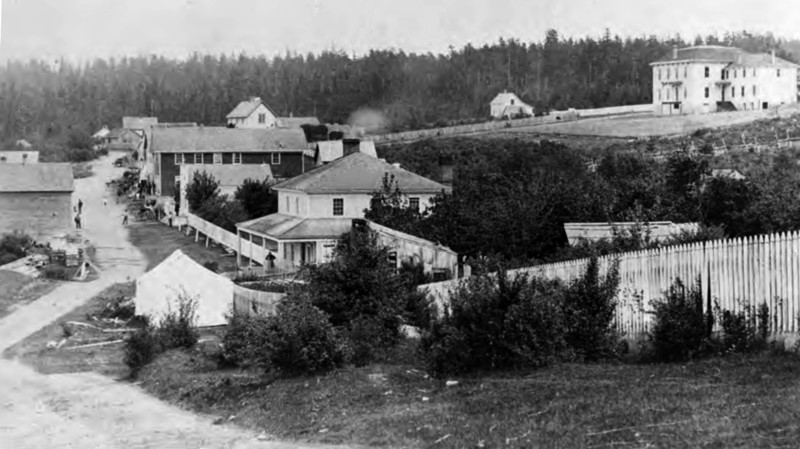
The building around 1884 between the Good Temperance Lodge and "Mother Fay's Hotel" (later the State Hotel)
Courtesy: Whidbey Island Historical Musem, Coupeville.
1885 - C.J. Cramer, watchmaker and jeweler was in Dr. Harrison's Drug Store.
Quote from "A Particular Friend, PENN'S COVE" by Jimmie Jean Cook
On February 12, 1885, C. J. Cramer had set up as a watchmaker and jeweler in Dr. Harrison's drug store. Beneath the advertisement for Cramer was a notice from Dr. Harrison requesting that all persons indebted to him please come in and settle accounts at the earliest possible date. J. W. Fox would be on hand to issue receipts. Next to that notice is an ad listing the business for sale, "Dr. Harrison's neat little drug store stock complete, goods all fresh and new--will invoice about $1000. A fine opportunity for a doctor with small capital ."
The Harrisons had moved to the San Juan islands. They had been agents for the Stewart & Holmes Drug Co. of Seattle and this company supplied drugs to Coupeville for many years.
A short time later the saloon of John Leach was closed by female suffrage and he purchased the goods at the drug store and the building was known as Leach's Drug Store. In 1888 both Leach and F. Puget Race sold drug stock to Joshua Highwarden.
1888 - Dr. Joshua Highwarden purchased the building from Alexander and operated a drugstore. He raised the height of the door to accommodate his silk hat. John Leach of Leach's Drug Store and F. Puget Race sold drug stock to Mr. Highwarden.
Quote from "A Particular Friend, PENN'S COVE" by Jimmie Jean Cook
On June 7, 1888, J. and Ann Highwarden purchased the building from Alexander and it became known as A. Highwarden & Co. Joshua is presumably the company. The cost of the land and building was $600. The building was enlarged by Abram and Dr. Highwarden stocked it with French perfumes and fine toiletries. In addition to drugs. It also carried paints, oils, brushes, glass, putty and groceries, staple and fancy.
In 1890 the San de Fucan said that the business "carried a stock of $6000 in drugs and about $4000 in groceries. Dr. Highwarden has been at the head of the establishment for last ten (settle for two) years the and has made a host of friends, both as a tradesman and a physician. He is a broad-minded and liberal citizen and has done much for the upbuilding of Coupeville." He at least lifted the front door of the establishment. The height of this door is to accommodate the top hat that he wore.
In 1890 the firm was sold to Chauncey House and William Lang. House was elected County Auditor in 1892 and went out of the drug business.
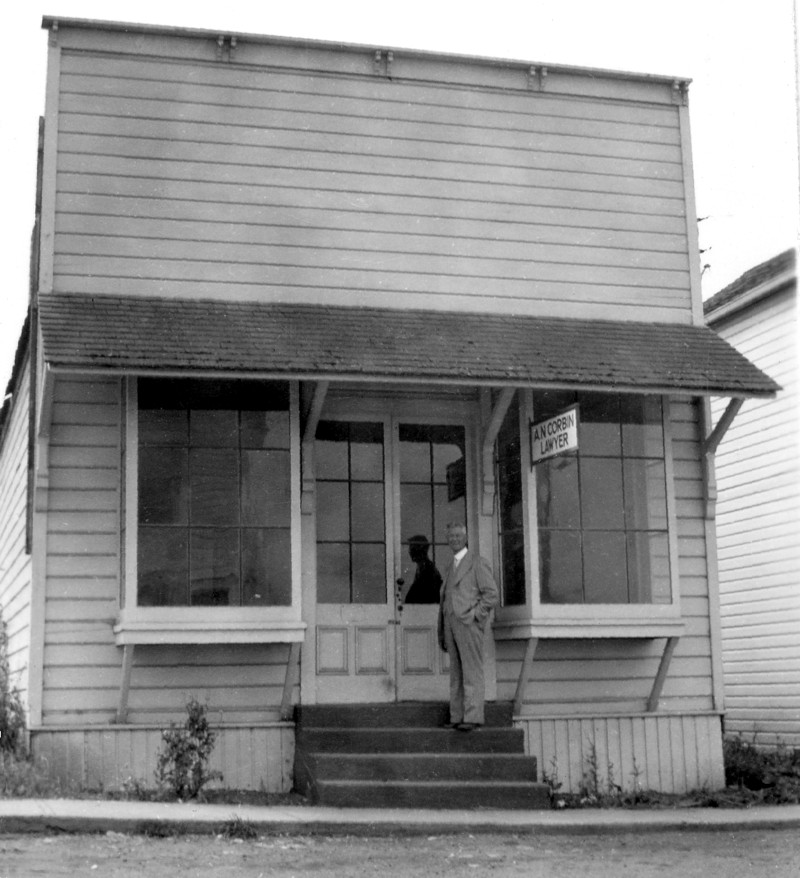
The building was occupied by A.N. Corbin
The same gentleman who had occupied the Judge Still Office (#17 NW Front Street)
Courtesy: The Private Collection of the Corbin family
Early 1890s - The building was used as a Post Office until a new one was built in 1938 (see #11 Front Street on this site.)
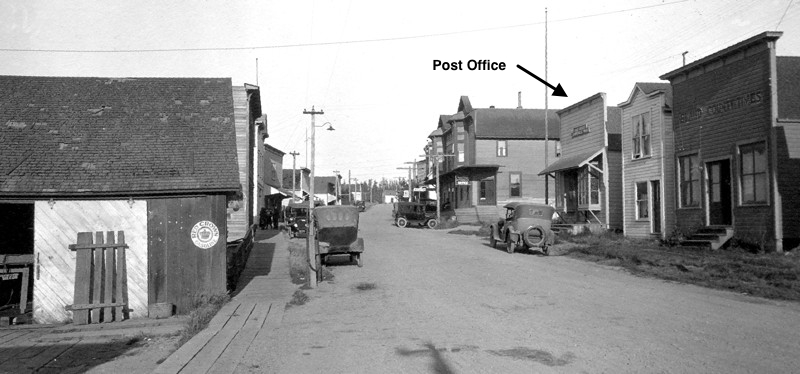
The building was used as a Post Office. It is the third from the right in this picture
Courtesy: Island County Historical Museum, Coupeville
Quote from "A Particular Friend, PENN'S COVE" by Jimmie Jean Cook
The building eventually became the post office and was so used for many years. It is now generally referred to as the Bishop building. Dr. Paul E. Bishop used it as his office for about eight years and ... engaged in active practice until his death.
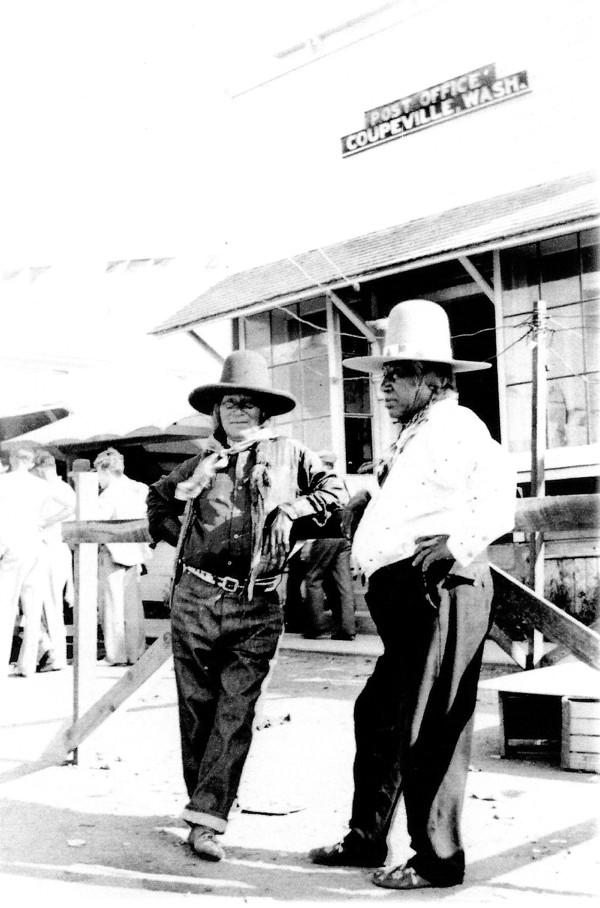
The post office during a water festival with native Americans
Courtesy: Island County Historical Museum, Coupeville
1938 - The Post Office moved to new building on the corner of Front and Grace (see #11 Front Street on this site.)
1942 - 44 (approximately) - Dr. Chafey's Office.
*Interview by Judy Lynn with Larry Zylstra, 2010:
[Note: Larry Lysle Zylstra passed away November 22, 2010, one month after this interview. The interview was edited and approved by his son, Gregg Zylstra.]
Judy: Let's go down the street and tell me what you remember about the buildings and businesses.
Larry: The next building [the Elkhorn Saloon] most of the time was used as a doctor's office. Dr. Chafey moved from my dad's old law office to that building. Then Dr. Bishop had it for a long time.
1949 - Dr. Bishop moved to Coupeville and opened office. "Dr. Paul E. Bishop MD, specialist in the diseases of men, women and children."
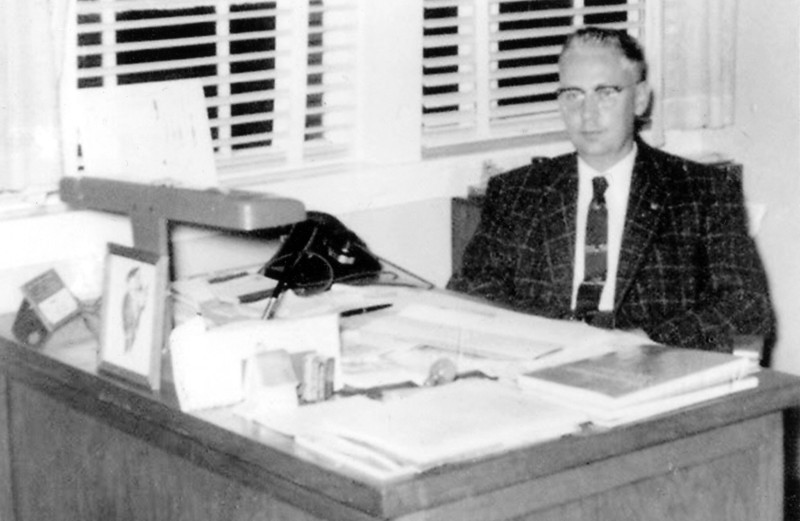
Doctor Bishop
Courtesy: Island County Historical Museum, Coupeville
*Interview by Judy Lynn with Leone Argent, 2009:
Dr. Bishop's office (Elkhorn Saloon building) was next door, which was the old post office building before the one was built on the corner. I remember him telling me he wished he could send those other pregnant gals to see how much I was exercising when I was pregnant with Dennis. He had patients who thought they had overdone if they had hung something on the clothesline. I went to Dr. chafey the first time to have my tonsils out. They gave me a knockout pill and told me to look at the telephone pole. "When it becomes two it will be time to take your tonsils out." He did remove my tonsils while Nurse Harpole held me steady as I sat on a chair. Later Dr. chafey was still in that office (on the north side of the street on East Front Street) when I was pregnant with our daughter, Joy. Then he moved to the building that had been the old post office. [The Elkhorn/Bishop building.] I saw Dr. Chaffe for pregnancy with our son Gene. This was the same building where Dr. Bishop was my doctor for my pregnancy with son Dennis. It was the first post office. It was fun to go down when it was time for the mail, when the boat came in. It was the most friendly group - a small town and I was just a kid. The mail was sorted while people waited and it was put in their boxes.
*Interview by Judy Lynn with Jean Sherman, 2009:
Judy: What do you remember about Front Street?
Jean: Doctor Chafey had an office in the Bishop (Elkhorn Saloon) building for a short time. He delivered my babies. His office was there before Doctor Bishop. When Doctor Bishop came my kids were older. Dr. Bishop was our doctor, of course. Dr. Chafey became a medical missionary and went to Africa. Vin [Jean's son] and his son were in school together. Dr. Chafey was "expensive." He charged $50 for the delivery and medical care for the next year.
Polly Harpole was a registered nurse. I was in labor with Vin and [my husband] Edwin was sitting there. Polly said, "I have to go downtown to get my mail. I was delivering Vin while she was downtown. Edwin got in the car and went to get her. Edwin delivered Vin and Polly was there immediately. Doctor chafey was on his way from Oak Harbor. I started hemorrhaging and almost died. I weighed 90 lbs when I got out. I went home with this little baby and was sicker than a dog.
*Interview by Judy Lynn with Malcolm Bishop, 2007:
Judy: Tell me about how your father came to Coupeville to be the doctor on Front Street.
Malcolm: My dad, Doctor Paul Emery (or Emory) Bishop, came to Coupeville in 1949 from Bainbridge Island. He was born in a farm house on the Bishop homestead near Garfield, Washington. He was in the Army as a doctor at the end of the war (World War II). I don't know what he did in between that and when he came here (Coupeville). I was born in Portland and lived in Winslow on Bainbridge until '49 while he was in the Army. He also worked at the shipyards.
Judy: How did he find Coupeville?
Malcolm: B Wilbur Sherman and other prominent people in Coupeville were seeking a doctor by advertising. They convinced my dad to come to Coupeville. When we moved from Winslow to Coupeville, we lived in the chafey house at the southeast corner of Madrona Way and Vine Street. We rented the house from the chafey's for a year and a half and the office on Front Street (in the Elkhorn Saloon building) as well. During that year and a half my folks purchased the office and built a house off Sherman Road.
Judy: When did Doctor chafey have his office in that building?
Malcolm: Doctor chafey was in the office after 1940…..closer to '42 or '44. We know that because of records we found in the building. Doctor chafey became a missionary. The office was vacant when we moved to Coupeville.
Judy: Would you describe the building?
Malcolm: The southeast corner was an X-Ray room and the south side of that was a darkroom. There was an examination table in the X-Ray room. In the southwest corner, adjacent to the X-Ray room was an examination room with a table. That's where he did a lot of setting broken arms, minor surgery, and stitching.
There was an addition on east side that my dad put on, that gave access to the back room. From the back, the hallway turned right to the north in front of the exam room into the front waiting room. Or when you'd come in the front door at the north end of the building, you entered the waiting room. His office was on the left which is the east side just past the waiting room and on the west side opposite his office was the nurses' station. Between the office and nurse's station was the hallway leading to the exam room and X-ray room. In the hallway just before it turned left to the east there was a step up. My dad's office was on the lower part.
There was a wood stove in the center of the waiting room toward the west. In the front room [waiting room] there was a library table where the magazines were. [Malcolm pointed out the library table in their living room.] A wood shed was attached to the south end of the building. It had a very poor floor. It was an add-on but I don't know when it was done. It was there already.
I remember collecting driftwood at Ebey's Landing for the wood stove and putting it in the wood shed. I don't remember stoking the fire. I just remember it was warm in there. In the hallway there was an oil stove and outside on the west side a 250 gallon oil tank on stilts. I remember wire brushing it and paining it silver. There was very little space in between the buildings.
My brother Lyall has the sign that was over the front of the office. It was hung over the door and perpendicular to the door so you could read it from both sides. It reads "Dr. Paul E. Bishop MD, specialist in the diseases of men, women and children."
Next door, between his office building and the post office (the concrete block building at the corner of Grace and Front) was an empty grassy lot. My dad entered his office by driving down Grace off Coveland Street and I don't remember it being paved. He parked near the wood shed at the south end of the empty grassy lot.
We still have his car, a 1955 Chrysler 300. When he started the practice he had a '49 Packard. This was the first time he had his own business.
The building was white and had white window sashes until I painted them fire engine red. It was a horrible job. I painted the stairs red too. There were always geraniums planted on either side of the stairs under the windows.
My mom sold the building sometime after dad died. He died March 3, 1962. Doctor Brobyn was the next doctor in town but I don't know if he used the office….maybe a short time. My mom had a lot of pressure by people to sell to him but she didn't want to, she didn't feel comfortable with Dr. Brobyn. When she did sell it, in 1964 or '65, she got more money. The sale wasn't complete until 1967.
Judy: What else do you remember about the building?
Malcolm: My two oldest brothers and me, and sometimes Stephen, spent time painting. I helped set broken arms, removing casts and mixing plaster. I liked to do that. I helped with X-Rays on Saturdays and Sundays. There were office hours but not like today. It was much looser then. My dad liked farming. We had a little farm at home on Sherman Road. He left after the chores at home were done and would go to the office at 9:00 or so. At 3:00 or 4:00 when he'd finally seen all his patients, he would leave and spend the rest of day making house calls often until 9 pm or later. If someone broke their arm on Saturday or Sunday, that is what he'd be doing. He would go to White Acres nursing home in Freeland on Sundays after church. Often times the whole family would go along so we could go across the street and eat lunch at Kimble's Restaurant.
I remember the first and only time I smoked a cigar. I was afraid my dad would find out so did it in the wood shed at the back of the office. To get rid of the smell on my breath, I went across the street to Hurd's Drug Store and got a Payday candy bar. I got so sick and have hated those Paydays ever since. My cousin John Bishop was the one that put my up to the cigar smoking, he was a bad influence.
....
Judy: Would you tell me about your dad's death?
Malcolm: Dad died of a heart attack, Saturday, March 3, 1962. It had snowed quite heavily and I remember my mom yelling at me to come right away, I was still in bed. My two oldest brothers were at WSU. He died at home in bed.
ADDITION BY WILBUR BISHOP
Our dad died on March 3rd. Brother David's birthday is March 2 and David got a present, I believe like a model car and I remember that evening daddy saying he was tired and he would help David with it tomorrow...that was the last thing I remember him saying. But also I know how our memories get foggy.
He lived a busy life and died at 47. Often times he wouldn't get home until late. Sometimes he was home for dinner but more often we didn't see him until morning. In the morning there'd be some bread on the counter. (He was often paid in trade.) My mom kept the books and quite often there were heavy discussions about collecting money from certain people. Dad hated collecting. I know once we had a load a lumber delivered. We used that load of lumber for years. People brought fish and a lot of stuff in payment. I know he would visit a lot of elderly patients and they just needed to talk. They fed him cookies, bread, and such….all of which he shouldn't have.
I know my dad was really welcomed to the town. He proved himself as a family doctor and he was here to stay. He was the right person for the area.
My dad had a plane, a Piper J-3, that he kept at the Arnold Farm. He and Vern Beur rebuilt the plane but Vern did most of the work. Later my dad bought some floats and kept them in the east side of the dock in San de Fuca. He had a boat to go to and from the plane. His dream was to commute to the Everett Hospital by air because the ferry was unpredictable. I know that if he had a real emergency, he or someone would call and have the ferry held. That happened on a couple of occasions. He drove very very fast - he was noted in town for fast driving. His favorite magazine was Motor Trend. He was really interested in cars.
I remember one day I was painting the baseboard in the hallway at the office and the phone rang. He hung up and said, "Put your paint brush down. We're going for a drive." No cars had seat belts at that time, but he had installed aircraft seat belts in the Chrysler, tied to frame with cable. We were south of Race Road and he told me to look at the speedometer but, "Don't tell your mom." We were going 150! He drove the Packard (a previous car) fast too.
Years ago the story was told that he went to the Sheriff's office one day and the Sheriff said, "Doc, I tried catching you last night but I couldn't keep up with you." He was a very good driver. I remember waking up one morning when we were in the chafey house, seeing a deer in the yard with it's throat cut. There was a piece of grill missing from the car. He obviously hit the deer and cut it's throat to put it down. The deer was given away to someone. It didn't go to waste.
*Interview by Judy Lynn with Roger Eelkema, 2009:
Roger: The next building was the Bishop Building. Dr. Bishop was well liked. He gave me asthma shots and probably saved my life two or three times. He would come to your house. Dr. Chafey had his office there before Dr. Bishop. He lived at Madrona and Vine and had been a missionary.
*Interview by Judy Lynn with Ed Youderian, 2010:
Ed: Doctor Bishop was there, and before him was Dr. chafey. They were very good, devoted, family doctors. We had a guy, Joe Fisher, before I got to high school who was on the basketball team. He had his shoulder knocked out before he started playing. Dr. Chafey would come to games with a rolled up towel. If Joe's shoulder would pop out during the game, Dr. Chafey would pop it back in, holding the towel, and Joe went back to playing basketball. They came to play, not worry about them hurting a little bit. Joe's family lived on the island on Kennedy's Lagoon.
Bob Armstrong was another one. He was playing football and got his ankle hurt bad. We were lucky to get 11 guys on the field. They taped him up some and he played the rest of the game. After the game they x-rayed it and he had a broken ankle. He had played the rest of the game on a broken ankle. You had to knock 'em out to keep 'em out of it.
Dr. Bishop - I hate to admit this - but if you went in there and mentioned anything about cars and engines - he treat you, but then he'd sit there and talk about cars for a half hour. He had a Chrysler 300 and it had lots of "snooze". He'd make trips to Seattle and sometimes he and Polly Harpole would be coming back on the same ferry. They would race up the island. Polly drove like Mario Andretti - absolute smoke. This was when the road was no more than a cow trail.
1962 - Dr. Bishop died.
1967 - Sale of building complete
1971 - La Tienda Mexican store opened.
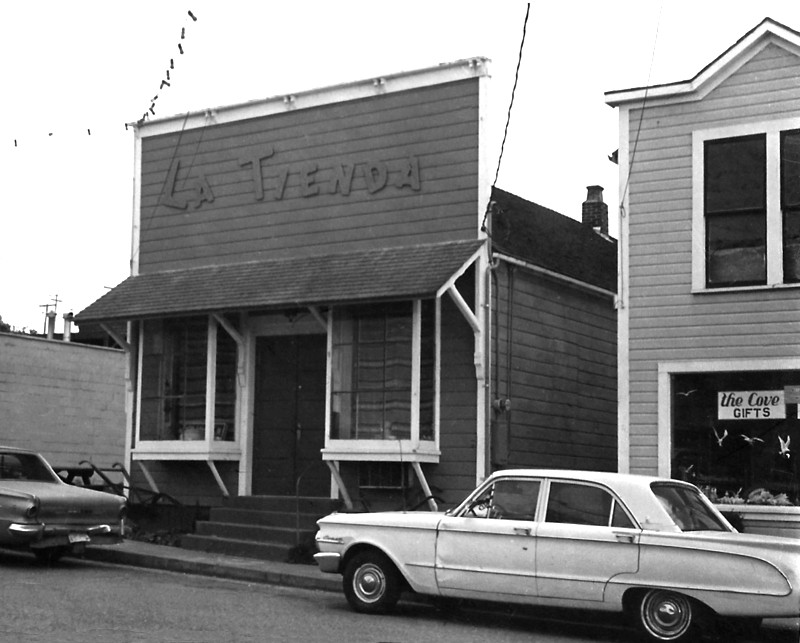
La Tienda
Courtesy: Ebey's Landing National Historical Preserve
Early 1970's - Ken Kroll sold the building to Lynn and Bob Jackson for Coupeville Weaving Shop.
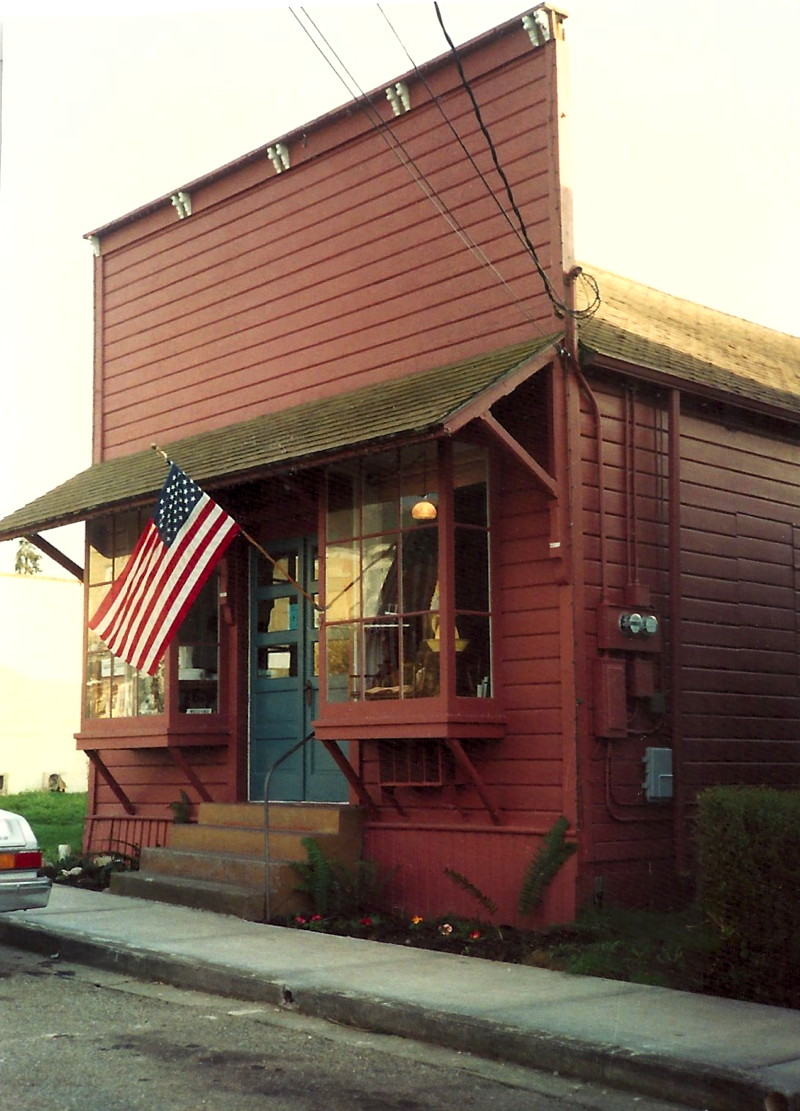
Coupeville Weaving Shop
*Interview by Judy Lynn with Joan Wieringa, 2009:
Judy: Who else do you remember being in business there?
Joan: Lynn Jackson had the Coupeville Weaving Shop, (Elkhorn Saloon building) which was a lovely place. Bob Jackson was very involved in helping with the shop.
1983 - Lee & Jim Anderst bought the building from Bob Jackson.
*Interview by Judy Lynn with Lee Anderst, 2008:
Judy: Tell me about your life on Whidbey Island and how you happened to buy the Coupeville Weaving Shop on Front Street.
Lee: Jim and I were going back to the land. We lived on a farm south of Coupeville. We added sheep to the mix for the meat and were interested in using the whole product so we thought we should use the wool. Ann Goldstein and I took spinning lessons from Rose, a spinner in Anacortes. I took two spinning lessons and I was in love. That was in June 1982. I don't remember how I found out the Coupeville Weaving shop was for sale. Maybe company came to town and we took them to Front Street, which was the only time we went to town. We were working on the farm.
I convinced Jim that having a shop on Front Street would be the most wonderful thing in the world. I envisioned myself spinning by the Franklin stove during the winter and spending the summer selling to eager tourists. The reality is that I haven't spun since. I never learned the craft. We were buying a weaving shop. It was the "Coupeville Weaving Shop." We changed it to "Coupeville Spinning and Weaving Shop" so it would reflect what we did
....
Judy: The photos of your shop show the sign over the door reading "Coupeville Weaving Shop."
Lee: We never changed the shop sign over the door to add spinning. We were always on a tight budget in those days and Coupeville Weaving Shop would draw in the same people that a Coupeville Spinning and Weaving Shop did.
Judy: Did you change the building when you bought the business?
Lee: My ideas of sitting by the fire all winter quickly gave way to the reality that we needed as much display space as we could find, so the Franklin stove came out. We didn't make any other structural changes. The Jackson's didn't use the back of the shop, but we used every inch we could for display and then the classroom in back doubled as my office. Our main heat source was the old oil stove that had been there when Doc Bishop's office was in that building. We would have people come in and reminisce about coming to see Doctor Bishop and the scale was right by that stove. The side rooms off the main room that we used for yarn display used to be examining rooms. I just remember trying to find jobs I had to do in that part of the shop because it was darn chilly many mornings. It was a good building for wool sweaters!
Judy: When did you close the shop?
Lee: As I remember it, I think we closed the actual shop in spring of 1991 - we rented the building to John Cunningham, a strange antiques kind of guy. Jim and I continued to take CSWS inventory to various conferences for another year. Meanwhile, John Cunningham sort of disappeared and that's when George Lloyd moved Salmagundi in and I think bought the shop a year later (1993? Could be 1994). (George said it was 1991.) George would probably remember the actual sale year. I remember it was September 13, because that is the day in 1982 we bought it from Bob Jackson.
1991 - The Anderst's closed Coupeville Weaving.
1992 - The Anderst's rented the building to John Cunningham as an antique store. Later in the same year, the Anderst's sold the building to George Lloyd. Lloyd opened Elkhorn Trading Antiques.

Elkhorn Trading Company Antiques
Courtesy: Robert Y Elphick, 2013
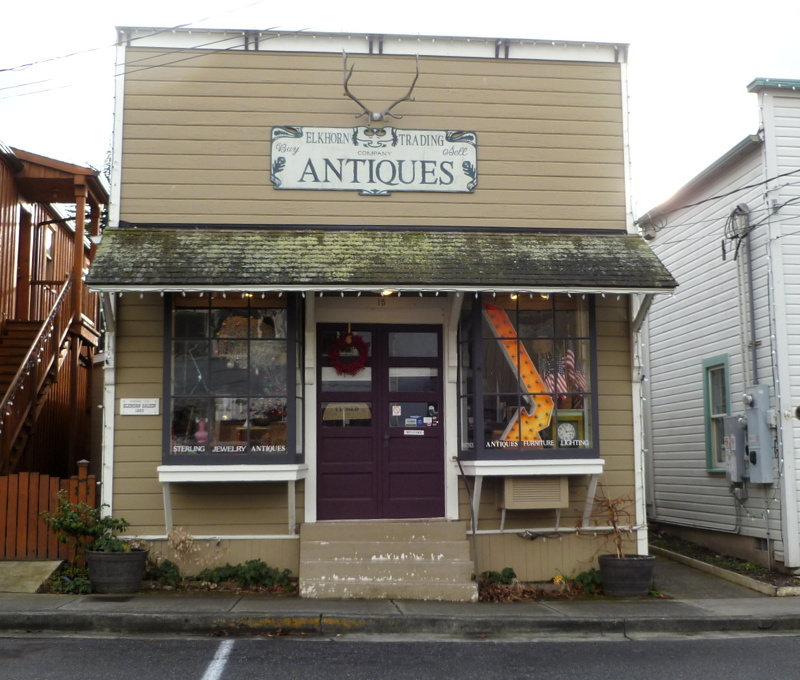
Elkhorn Trading Company Antiques
Courtesy: Robert Y Elphick, 2015
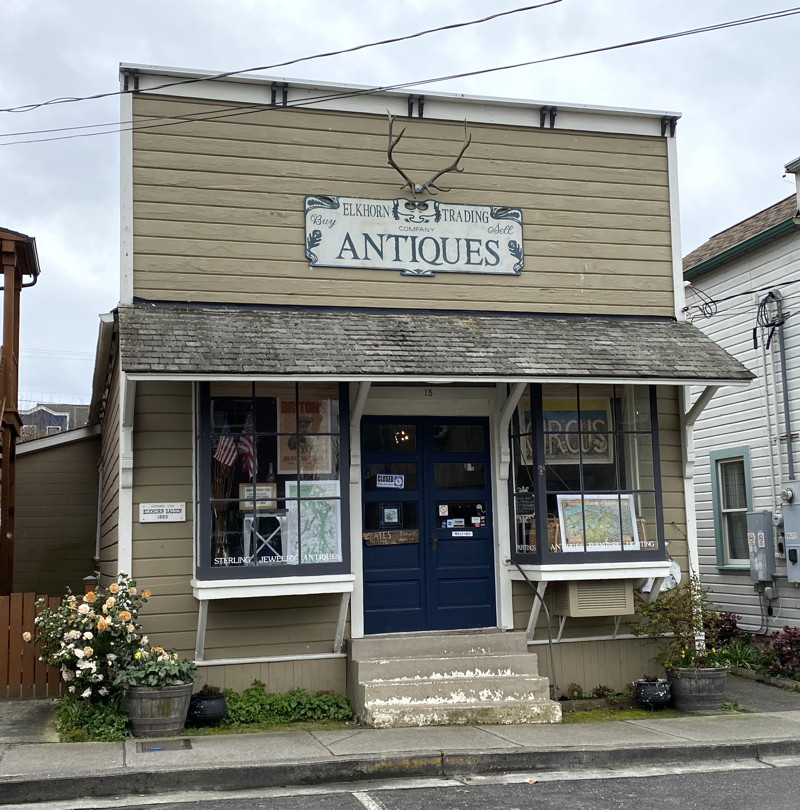
Elkhorn Trading Company Antiques
Courtesy: Robert Y Elphick, 2020
* All the interviews are extracted from the Judy Lynn's Oral History Project. Judy Lynn interviewed everyone she could find who had any memories of the history of Front Street. For more information on the project contact the Whidbey Island Historical Musem, Coupeville.
The e-book Front Street, Coupeville - An Oral History by Judy Lynn contains all the interviews. It can be purchased for $9.99 at Amazon.com for Kindle application or device or from the Apple Store for iBooks applications. Proceeds go to the Island County Historical Society.


